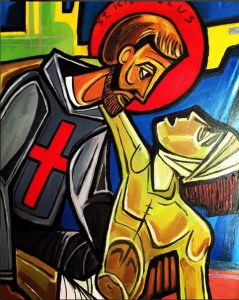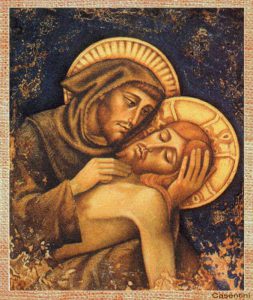 Occupying the first place in the hierarchy of beings is man and more particularly man when he is sick. Pity towards the suffering is a natural feeling in Francis. He cared for the sick even before his conversion and he came to their aid moved by compassion (Cel.VII, 17, 349). His instinct, however, had its preferences and its rejections. Although he was prepared to help some he was equally ready to abandon others, independently of their needs. Francis felt compassion for the poor but felt horror towards lepers, an ‘instinctive repugnance’, ‘great annoyance and disgust’ (2 Cel., 592), and to such an extent that he did not venture to drawn near to them in their homes, and in their presence he fled from them covering his nose (Tre Compagni, 1408).
Occupying the first place in the hierarchy of beings is man and more particularly man when he is sick. Pity towards the suffering is a natural feeling in Francis. He cared for the sick even before his conversion and he came to their aid moved by compassion (Cel.VII, 17, 349). His instinct, however, had its preferences and its rejections. Although he was prepared to help some he was equally ready to abandon others, independently of their needs. Francis felt compassion for the poor but felt horror towards lepers, an ‘instinctive repugnance’, ‘great annoyance and disgust’ (2 Cel., 592), and to such an extent that he did not venture to drawn near to them in their homes, and in their presence he fled from them covering his nose (Tre Compagni, 1408).
But the caprice of his instinct was corrected as soon as the message of Christ advanced in him. One of the first deeds of his conversion was to kiss a leper, a traumatic experience that he would remember even in his testament (110). From that moment onwards, the figure of the leper became the seal of his life. He remembered it in his rules, recommending the obligation to provide help (28). He established the first homes of his friars in refuges next to sick people afflicted by sores so that they could be helped. He put himself in the front line in works of service involving nursing. Bonaventure observed that he ‘washed the feet [of lepers], bandaged their wounds, removed rotting skin from their sores, and cleansed their purulence. Moved by admirable devotion, he also kissed their gangrenous wounds, he who would soon become the Good Samaritan of the gospel’ (Leg. Mag.,1045). Those who wanted to enter his family were sent to leper hospitals where in performing service they could verify the authenticity or otherwise of their calling’: ‘Noble or not, it was necessary for them to serve lepers and live in their homes’’ (Sp.perf.,1730 and 1658).
In service, joy had to be expressed by one who gave himself ‘willingly’ and attended to all needs at a ‘good level’, like Friar James when he touched sores, treated them and changed bandages (Leg. Per. 1569). Rule (30) reminded the friars to be ‘happy when they live amongst people of little importance’. Above all, however, the sick person had to be drawn near to with faith because in him was concealed the suffering Christ. Francis was severe with those who provided help without reference to faith. ‘Brother when you see a poor man, you are placed before the mirror of the Lord and his poor Mother. In the same way in the sick know how to see the infirmity with which Jesus is clothed’. This attitude was not an isolated episode but, rather, a premiss from which was derived, as a logical consequence, the habitual approach of Francis towards the suffering.



In the light of these testimonies, which could be further increased in number, it is easy to understand how the sick person entered the spirituality of Francis, and then passed on, by way of the school of the Capuchins, to Camillus. The image of the crucified Christ present in the oppressed, a passionate dedication to the exercise of mercy, thinking that everything that one has – faculties and physical resources, possessions and time – is not our property but that of those who are in need: these were the themes that were proposed anew by Camillus. Being aware of the figure of Francis and all of the spirituality that followed from him, one cannot but see it as a school from which the work of Camillus drew inspiration.
In Camillus, as well, we feel that ‘what there is, and what we have, belongs to the poor’ and refusal brings upon our heads divine judgement: ‘away from me wretched ones’. ‘Charity should be facts of a good spirit and a generous heart’ and beneath the clothes of a poor person Christ was concealed. Vocation to merciful service is a gift of which we are not worthy.
There is an interesting shared feature which unites these two founders: the codex of the mother. Francis, like Camillus after him, saw in a sick person the crucified Christ and at the same to time his mother. This particular strikes us because it returns in ‘On the behaviour of friars in religious houses’, where these friars are invited to engage in maternal care; in the two Rules which received a Bull and did not receive a Bull; and in the Legend of the Three Companions, of whom it is said that ‘they loved each other with deep affection…as a mother would do with her own tenderly loved only child’. Brother Pacifico addressed Francis calling him ‘dearest mother’ and Francis in his turn corresponded with the appellation ‘my tender mother’, a phrase which he also used with Brother Elia and Brother Leone.
The same maternal codex is to be seen in Camillus who bent down before a sick person as a mother does with her only child. In more than a hundred testimonies it is emphasised that ‘there was no mother who loved her children so much as Camillus loved his poor and dear sick’.
However, although in Francis charity was one of the very many themes of his life, it has to be recognised that in Camillus it constituted the sole centre of gravity of the whole of his soul. Those who drew near to him had to be prepared to hear nothing else but the preaching of charity: ‘from me you will hear nothing else but charity’.





